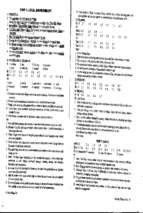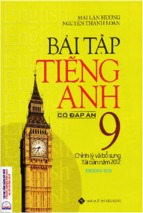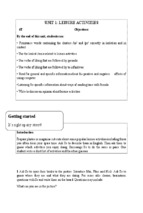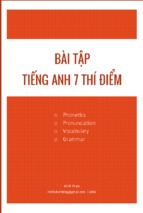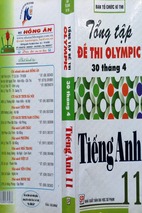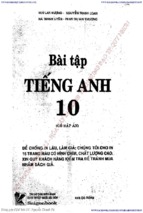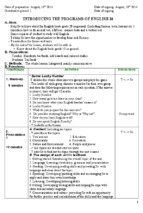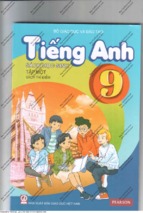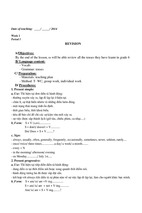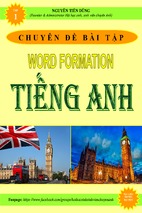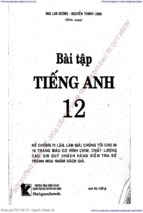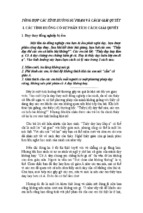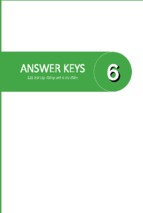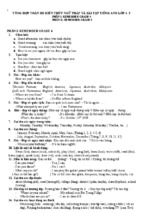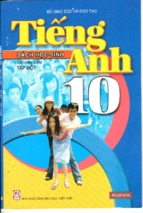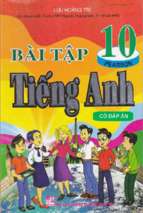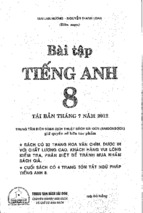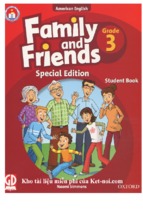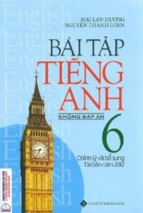Date of preparation: ….../……./ 2018
Date of Teaching: .…../……./ 2018
Giáo án Tiếếng Anh lớp 12 cơ bản thí điểm đầầy đủ UNIT
TIẾẾT 01:
INTRODUCTION OF ENGLISH 12
A. Aims:
- Help Ss to know about the English book grade 12 in general.(themes, tests, lessons etc.)
- Introduce how to do an oral test, a fifteen - minute tests and a written test.
- Some requires of student to study well English.
- To help Ss have the opportunities to develop their oral fluency.
- To introduce the theme and units.
- By the end of the lesson, students will be able to: know the topic, the theme and units.
B. Preparations: - Teacher: Handouts, textbook, boards, colored chalks and lesson plan.
- Students: Textbook.
C. Methods:
- The whole lesson: Integrated, mainly communicative.
D. Procedures:
Activities
Interactions
1. Warm-up (8 minutes) Introduces herself to the
students.
T <--> Ss
Asks some students to introduce themselves:
What’s your name? Do you like English?
Do you find English easy or difficult? Which is the easiest, the
most difficult? Reading, speaking, listening, or writing?
Why do you learn English?
Individually
How long have you learned English?
Are you good or bad at English?
2. Presentation (30 minutes)
1. The text- book English 12
- The 1st term: * Unit 1- Unit 6: 8 parts for each unit: getting started, language,
reading, speaking, listening, writing, communication and culture and looking
T <--> Ss
back & project
* Review 1, 2
* Test yourself 1
* Written tests: 6: 15’(3) 45’(2) end- term (1)
- The 2nd term: * Unit 7- Unit 12: 8 parts for each unit: getting started, language,
reading, speaking, listening, writing, communication and culture and looking
back & project.
* Review 3, 4
* Test yourself 2
* Written tests: 6: 15’(3) 45’(2) end- term (1)
2. Teacher’s demand:
- Read the lesson before studying in class.
- Do all exercises at home.
- It is good to find the meaning and the pronunciation of the new words in the
dictionary at home.
-Listen to the teacher attentively and take part in the lesson actively and
creatively.
- Take part in the activities that the teacher required such as pairs work, group
work or individual
- Each S has a notebook and book (student book and work book)
Books * Text - book English 12
* Work - book English 12
At home:
* Prepare for the new lessons: content, structures, words and phrases,
pronunciation
* Revise the old lessons + do all the homework
At class: * Participate in all activities * Keep the discipline
3. Consolidation (5 minutes)
Students’ assessment
T <--> Ss
What do you find your English? Very good/ excellent: Good:………
Average:……… Bad:……….. Very bad:………
- Give feedback.
4. Homework (2 minutes)
T <--> Ss
- Prepare Unit 1: Life stories
Lesson1: Getting started
E. Evaluation:
...........................................................................................................................................................................................................
Date of preparation: ………../……./ 2018
Date of Teaching: ………../……./ 2018
TIẾẾT 02:
UNIT 1. LIFE STORIES
LESSON 1. GETTING STARTED
A. Objectives:
1. Language focus:- To introduce the overall topic of Unit 1: “Life Stories”, lexical items related
to people’s life stories, homophones, revision of the past simple vs. the past continuous.
- To check students’ comprehension thorough True / False
- To provide Ss with a chance to express their opinion about their choice.
- To help learners get started with some language items in Unit 1
2. Skills: - To help learners get started with 4 skills in Unit 1.
- Reading: Reading for specific information in an article about Life stories.
- Speaking: Talking about a historical figures.
- Listening: Listening for specific information.
- Writing: Write a life stories.
3. Attitudes: - To help Ss get started for Unit 1 with the topic "Life stories"
- To provide Ss some motivation
B. Preparations: - Teacher: Handouts, textbook, lesson plan, papers and cassette.
- Students: Textbook
C. Methods:
- The whole lesson: Integrated, mainly communicative.
D. Procedures:
Activities
Interactions
1. Warm up (5 minutes) Answer some lead-in questions.
1. Who is your favourite singer / footballer /…?
2. Why do you like him / her?
T <--> Ss
3. Look at the picture on page 6 and answer questions: Do you know who they are?
What do you know about them?
Possible answers: 1. My favourite singer/ footballer is Sơn Tùng/ David
Beckham.
2. I like Sơn Tùng most because he not only sings beautifully but he is also really
handsome. I like David Beckham very much because he both plays football
excellently and is manly.
3. I have no idea about the first photo. The second is Michael Jackson, a popular
American singer and dancer. The third one is a good cook / chef. And the last one
is two students. May be they are talking about the three people just mentioned.
2. New lesson Activity 1: Listen and read (15
minutes)
T <--> Ss
- Tell Ss that they are going to listen to a conversation.
- Play the recording
- Ask Ss listen to the recording and read the conversation.
+ Steven Paul “Steve” Jobs (February 24, 1955 – October 5, 2011) was an American
entrepreneur, marketer, and inventor, who was the co-founder, chairman, and CEO Whole class
of Apple Inc.
+ Michael Joseph Jackson (August 29, 1958 – June 25, 2009) was an American
singer, song writer, record producer, dancer, and actor.
+ Christine Ha (May 9, 1979) is an American chef, the first blind contestant of the
TV show Master Chef and winner of its third season in 2012.
Activity 2: Read the conversation again. Decide whether the statements are
T or F. (12 minutes)
- Ask Ss to work individually and finish the task
- Ask them to exchange their answers with a partner.
T (Quang says he hasn’t decided between Steve Jobs and Michael Jackson.) NG
F (Hung thinks Michael Jackson was a great dancer, but not an excellent singer
and his singing voice became weak and thin in his later years.)
F (Quang says M. Jackson’s music inspired him to learn to play a musical
instrument.)
T (Quang says Christine Ha won the US Master Chef trophy in 2012. Hung says
Christine is a blind chef and a gifted writer, very talented and determined, and it
was absolutely amazing to watch her use all the kitchen tools and prepare the
dishes.)
T (Hung says Christine is a blind chef.)
Activity 3: Discuss with a partner.
If you were Quang, who would you choose to talk about, Steve Jobs or Michael
Jackson? Why?
- T has Ss read the question and discuss their answers with a partner; elicits some
answers and writes the best ones on the board. - Ss discuss in pairs and answer
the questions.
Possible answers:
1.If I were Quang, I would choose to talk about Steve Jobs because he is amazingly
talented - he was an entrepreneur, marketer, and inventor, who was the cofounder, chairman, and CEO of Apple Inc.
2.If I were Quang, I would choose to talk about Michael Jackson because he was a
wonderful singer, a professional dancer, a great song writer, a leading record
producer, and a popular actor.
Activity 4: Find the words in the conversation that have
the same sounds as the following.
- T explains briefly to Ss that many English words (or combinations of words) may
have the same pronunciation, but different spellings and different meanings. They
are called homophones.
1. too
2. eye
3. sea
4. one
5. no
Feedback: 1. two
2. I
3. see 4. won
5. know
Activity 5: Read the conversation again and write the correct tenses of the
verbs in brackets.
This activity focuses on revision of the past simple and the past continuous.
- T asks Ss to give the correct tenses of the verbs in brackets first, and then has Ss
read the conversation to check their answers. Feedback: 1. became, wasn’t
2. felt, was creating
3. Consolidation (2 minutes)
- Ask Ss: What have you learnt today? What can you do now?
- Summarize the main points of the lesson.
4. Homework (1 minute)
- Ask Ss to learn by heart the words or phrases related to life stories. - Prepare for
the next lesson.
Individually
T <--> Ss
Pair work
T <--> Ss
Individually
T <--> Ss
Individually
and pair
work
T <--> Ss
T <--> Ss
T <--> Ss
E. Evaluation:
...........................................................................................................................................................................................................
Date of preparation: ………../……./ 2018
Date of Teaching: ………../……./ 2018
TIẾẾT 03:
UNIT 1. LIFE STORIES
LESSON 2. LANGUAGE
A. Aims and Objectives:
1. Language focus: - To provide learners some language items in Unit 1
- For vocabulary, that is words and phrases related to people’s life stories
- For pronunciation, that is homophones in connected speech
- For grammar, the use of the past simple vs. the past continuous and use of articles
2. Skills:
- To promote Ss to develop the skill of working in pairs and groups
3. Attitudes: To encourage Ss to work harder, to provide Ss some motivation
B. Preparations:- Teacher: Handouts, textbook, pieces of papers, lesson plan and cassette.
- Students: Textbook
C. Methods:
- The whole lesson: Integrated, mainly communicative.
D. Procedures:
Activities
Interactions
1. Homework (3 minutes) Tell about the person you
admire.
T <--> Ss
What’s his / her name? What does he / she do? What is he / she famous for?
Does he / she inspire you to do anything? What is it?
2. New lesson
A. Vocabulary: (8 minutes)
Activity 1: Write the words given next to their meanings.
- T asks Ss to match the words with their meanings
- Ss read the words and their definitions in the box and then do the matching.
- Ss give the Vietnamese meanings of these words and then practise pronouncing
them.
- T checks answers as a class.
Feedback: 1. Figure: hình ảnh 2. Talented: có tài
3. distinguished: lỗỗi lạc, xuấất chúng 4. Achievement: thành tích
5. respectable: đáng kính trọng 6. perseverance: tính kiên trì
6. generosity: lòng bao dung
Activity 2: Complete the sentences with the correct forms of the words in 1.
- T asks Ss to pay attention to the grammar when using the words in 1. When
using a noun, Ss need to consider its suitable form (singular or plural).
- T has Ss complete the sentences individually, and then compare their answers in
pairs.
- Ss complete the sentences with the correct forms of the words in 1. Then
compare their answers in pairs.
- T checks answers as a class.
Feedback: 1. distinguished 2. talented
3. achievements
4. respectable
5. generosity
2. Pronunciation: Homophones (10 minutes)
Activity 1: Listen to pairs of sentences. Write the correct words in the
gaps.
- T asks Ss to study the Do you know…? box and practise saying the pairs of
homophones using the correct pronunciation; tells Ss that they are going to
listen to the recording and write the words they hear in the blanks; asks Ss to
read the two sentences a and b carefully, and decide on the part of speech of the
missing words.
- T checks answers as a class.
- Ss study the Do you know…? Box; listen to the recording and write the words
Individually
Pair work
T <--> Ss
Individually/
they hear in the blanks; Ss work in pairs, discuss the meaning of each word and
choose the correct one for each sentence.
Feedback:
Pair work
Activity 2: Listen and repeat the sentences in 1.
- T plays the recording again and has Ss repeat each sentence chorally; asks Ss
to read the sentences in pairs.
2. Grammar: The Past Simple vs. the Past Continuous
Activity 1: Underline the correct word (8 minutes)
T <--> Ss
- T has Ss review the use of the past simple and the past continuous; asks Ss to
look at the Remember box and draws their attention to the examples and asks
them guiding questions: In the first example, which verb indicates an action in
progress? Which verb indicates a shorter action that interrupts it? What kind of
action does the second example indicate? Why is the adverb “always” used?
- Ss listen to the tape again and repeat the sentences chorally.
- Ss read the sentences in pairs.
Feedback:
1. went, was having
2. met, was traveling
3. was working, was, were
4. shared, was always taking
5. called, was doing, did not hear 6. was constantly asking, was
7. requested, was composing
8. joined, was then leading
Definite articles and omission of articles
Pair work
Activity 2: Complete THE gaps with the where necessary. If an article is
not necessary, write a cross (). (6 minutes)
- T asks Ss to study the Do you know…? box and draw their attention to the
special cases (use of the and omission of articles).
- T asks Ss to complete the gaps with the or a cross () if an article is not
Individual
necessary.
- T has Ss compare their answers with a partner.
- Ss look at the Remember box and pay attention to the examples.
- Ss read each sentence carefully and decide which action is in progress and
which one is a shorter action that interrupts it.
- Ss complete the sentences.
Feedback:
Ss <--> Ss T
Indefinite articles
Activity 3: Complete the gaps with A, AN or a cross () if an article is not
necessary.
- T asks Ss to study Do you know…? box.
- Ss study the Do you know…? box. DO YOU KNOW…?
The definite article THE is generally used before a singular or plural noun when
we talk about a specific thing or action.
Examples: The dog that bit me ran away.
They like the films directed Steven Spielberg.
- T asks Ss to complete the gaps with an indefinite article or a cross () if an
article is not necessary and draw their attention to sentences 7 and 8, in which
the nouns (ice cream, coffee) can be countable or uncountable.
- Ss read the sentences carefully and underline the nouns / noun phrases after
the gaps.
Feedback:
<--> Ss
Ss <--> Ss
Individually
T <--> Ss
Individually
T <--> Ss
2. a. allowed b. aloud
3. a. write
b. right
4. a. new
b. knew
1. the
3. ,
2. the, the 4.
5. a. here b. hear
6. a. been b. bean
5. the, , the
7. , the,
6. the, , , the, the 8. the,
2. ,
4. , a, 6. a, , a
8. a,
Actvity
a 3: Read the following story and complete each gap with an artcle.
Individually T <-Write a cross () if an article is not necessary.
T tells Ss that to do Activity 4, they need to consider whether to
use a defnite article, an indefnite article, or no article at all for > Ss
each gap in the story; asks Ss to read the whole story frst to
understand the context before completing the gaps; has Ss
compare their answers with a partner.
T checks answers as a class.
Feedback:
a4. a / the7. the10. the 2. 5. the8. the11. a
3. a6. 9. a12. a
3. Consolidaton (2 minutes)
T <--> Ss
Ask Ss: What have you learnt today? What can you do now?
Summarize the main points of the lesson.
Expected answers: I can use: Homophones in connected speech The past simple vs.
the past contnuous and use of artcles
4. Homework (1 minute)
T <--> Ss
T asks Ss to do exercises again at home.
Prepare for the next lesson.
Complete Exercises in workbook.
E. Evaluation:
………………………………………………………………………………………………………………………………………………..
Date of preparation: ………../……./ 2018
Date of Teaching: ………../……./ 2018
TIẾẾT 04:
UNIT 1. LIFE STORIES
LESSON 3. READING
A. Aims and Objectives: - To teach Ss to scan a text for specific information about two people’s
life stories and carefully read it for more detailed information through completing the/ a
table with correct information and answering questions.
- To teach Ss new vocabulary by finding words or expressions with the definitions given.
1. Language focus: To provide learners some vocabulary related to people’s life stories.
2. Skills:
- To promote Ss to develop their reading skills
- Skim the text to get the general idea
- Scan the text to get some specific details
3. Attitudes: - To encourage Ss to work harder/ - To provide Ss some motivation
B. Preparations: - Teacher: Handouts, textbook, pieces of papers, lesson plan and cassette.
- Students: Textbook
C. Methods:
- The whole lesson: Integrated, mainly communicative.
D. Procedures:
Activities
Interactions
1. Check up (8 minutes) Choose the correct words from the
box to fill in the blanks.
- T has 2 Ss do this on the poster hang on the board.
- Other Ss observe and give comments.
piece
genes
he’ll
threw
brake
peace
jeans
hill
through break
1. You should have a
now. You’ve been working non-stop for four hours.
2. Bryan’s got an ankle sprain, but I believe
overcome his injury to win the
gold medal.
3. Alex said his day was very busy, and he just wants some
and quiet now.
4. Angela
a stone into the river.
5. Blue
, the most popular clothing item in the world, were invented by
Jacob Davis.
T <--> Ss
Feedback: 1. break 2. he’ll
3.peace 4. threw 5. jeans
2. New lesson (12 minutes) Giving back to the community Activity
1: Discuss with a partner.
Who do you think the people in the pictures are? What do they need? What can you
do to help them?
Use the words under the pictures to answer the questions.
Picture a: flood/ food/ shelter
Picture b: shabby classroom/ study
equipment
Picture c: cancer/ care/ comfort
Who and what they need
a. flood victims who need food and shelter
b. students studying in a shabby/ dilapidated classroom who need study equipment
and a decent place to study
c. young cancer patients who need care and comfort
What to do: a. donating money, rice, old clothes
b. donating books, money
c. visiting them and giving gifts, organising different activities
Feedback: The answers vary.
Activity 2: Read two people's life stories and complete the table with facts
about them. (12 minutes)
- T tells Ss that they are going to read the life stories of 2 people and complete the
table with facts about them.
- T checks answers in pairs and then as a class.
Feedback:
Name
Larry Stewart
Le Thanh Thuy
Born
1948
1988
Died
2007
2007
Nationality
American
Vietnamese
Health problem
cancer
bone cancer
Dedicated life to...
the needy
young cancer patients
Activity 3: Find the words or expressions in the text that have the following
meanings. Write them in the correct spaces. (10 minutes)
- T asks Ss to work in pairs and asks them to read the definitions.
- Ss read the definitions and find the words or expressions.
Feedback:
the needy: người thiêấu thỗấn ['ni:di]
reveal: bộc lộ, tiêất lộ [ri'vi:l]
anonymous [ə'nɒniməs] vỗ danh
amputate ['ӕmpjuteit] cắất chi
memory: trí nhớ ['meməri]
initiate [i'niʃieit] khởi xướng
Activity 4: Read the stories again. Answer the questions.
- T asks Ss to read the stories individually again and answer the questions by
writing complete sentences or just taking short notes; has Ss work in pairs, taking
turns to ask and answer the questions. - T checks answers as a class.
Feedback:
1. Every Christmas, Larry handed out thousands of dollars to
needy people in public places.
2. Because he gave money to people during the festive season of December while his
identity was hidden.
3. People have been inspired to continue his mission of kindness and charitable
work.
4. Thuy organised charity activities to relieve young cancer patients’ pain.
5. She was awarded the title “HCM Outstanding Young Citizen”.
6. The newspaper organises annual events to support her program. One of them is
Pair work
T <--> Ss
Pair work
T <--> Ss
Pair work
T <--> Ss
Individually/
Pair work
the Sunflower Festival, where children and their families get together and have
fun. Gifts are given to the young patients, and the memory of Thuy is kept alive by T <--> Ss
retelling the story about love and sharing.
Activity 5: Discuss with a partner.
Have you ever taken part in the Sunflower Festival to support Thuy's Dream
Programme?
- T has Ss work in pairs and discuss the questions. - If Ss have never heard of Thuy’s
Dream Programme or the Sunflower Festival, T encourages them to search the
Internet for information before they answer question b.
Possible answers:
Pair work
No, I didn’t.
I’d like to do it in the future. I’d paint portraits/ make sunflowers /perform chicken T <--> Ss
dance to help. I would like to do these things in order to ease cancer patients’
sufferings.
3. Consolidation (2 minutes)
- Summarize the main points of the lesson
T <--> Ss
4. Homework (1 minute)
- Ask students to learn by heart the new words.
T <--> Ss
- Prepare for the next lesson.
E. Evaluation:
...........................................................................................................................................................................................................
Date of preparation: ………../……./ 2018
Date of Teaching: ………../……./ 2018
TIẾẾT 05:
UNIT 1. LIFE STORIES
LESSON 4. SPEAKING
A. Aims and Objectives:
- To teach Ss to talk about some famous historical figures of
Vietnam to be able to talk about a historical figure’s life story.
- By the end of the lesson, students will be able to:
+ Express their opinion about some famous historical figures.
+ Perform their viewpoints to other people in real life.
B. Preparations:
- Teacher: Handouts, textbook, lesson plan and pieces of papers.
- Students: Textbook
C. Methods:
- The whole lesson: Integrated, mainly communicative.
D. Procedures:
Time/Stages
Activities
Interactions
1. Check up
Look at the picture and say who he is.
8 minutes
Possible answer: He is Nguyen Trai, a famous historical figure
of Vietnam.
T <--> Ss
2. New lesson 8 A historical figure
Activity 1: Choose the correct sentences (a-e) to complete
minutes
the conversation between two friends.
- T has Ss read the conversation quickly to get the main idea.
- Ss practise pronouncing new and difficult words.
Feedback:
1.d 2.a 3.c 4.e 5.b
Activity 2: Practise the conversation with a partner.
- T asks Ss to practise the conversation in pairs.
- Ss practise the conversation in pairs.
Activity 3: Choose one topic. Use the information below or
your own ideas to make a similar conversation.
13 minutes
- T has Ss read the conversation again and complete the
information about Nguyen Trai.
- Ss choose one topic and make a similar conversation.
Feedback: Conversation 2
13 minutes
John: Hi, Van. What are you doing? Why are you talking to the
mirror?
Van: Well … I’m practising for the storytelling contest next week.
I want to see my expression while I’m speaking.
Individually
T <--> Ss
Group work
T <--> Ss
John: I see. The topic is the life of a historical figure, isn’t it?
Pair work
Van: That’s right. I’ve decided to talk about Le Quy Don.
John: Le Quy Don? Who is he?
Van: He was a distinguished philosopher, poet, and
encyclopaedist ([en,saikləu'pi:dist] nhà bách khoa), he was
responsible for a large number of encyclopaedic
([en,saikləu'pi:dik]), historical and philosophical ([,fil ə's ɔfikl])
works.
John: Wow! He is a real national hero. Do you know any stories
about him? An interesting story will hold the attention of your
audience and the examiners.
Van: Yes. This is an interesting story about him: When he was Ss <--> Ss
still a child, he created a poem, using words with double
meanings to describe the characteristics of different types of
snakes. The poem can also be interpreted as a lazy student’s selfaccusation ([,ækju:'zei∫n]) and promise to study harder. He is
respected for his sharp wit and wide knowledge.
John: Excellent. Can you read the poem to me?
Van: Yes, I’ll read it at the contest. Why don’t you come to the
contest and listen to the poem?
John: OK, I will. I really want to know more about this famous
man.
3.
- Summarize what they have learnt by asking Ss some
Consolidation questions:
T <--> Ss
What have you learnt today? What can you do now?
2 minutes
4. Homework 1 - Ask students to learn by heart the expressions.
minute
- Prepare for the next lesson.
T <--> Ss
E. Evaluation:
………………...................................................................................................................................................................................
Date of preparation: ………../……./ 2018
Date of Teaching: ………../……./ 2018
TIẾẾT 06:
UNIT 1. LIFE STORIES
LESSON 5. LISTENING
A. Aims and Objectives: - To teach Ss listen for specific information about a talk show on
privacy and disclosure of people’s private lives.
- To provide learners some vocabulary related to the topic of life stories.
- To help Ss develop the skill of working in pairs and groups
- By the end of the lesson, students will be able to:
+ Listen and do the tasks.
+ Develop the listening skills for specific details.
+ Talk about the topic of life stories
+ Identify specific information through multiple-choice task and question answering
B. Preparations: - Teacher: Handouts, textbook, pieces of papers and cassette.
- Students: Textbook
C. Methods:
- The whole lesson: Integrated, mainly communicative.
D. Procedures:
Time/Stages
Activities
Interactions
1. Check up 7 - Talk about a historical figure well-known in Viet Nam or
Individually
minutes
around the world.
- 1 or 2 ss do as required in front of the class and other ss
T <--> Ss
observe. - Other students observe and give comments.
- Feedback
2. New lesson
13 minutes
Learning from people’s lives
Task 1: Why are people often interested in the life of celebrities
or famous people? Tick the possible reasons and add some Individually
more, if you can.
- T has Ss discuss the question with a partner; asks Ss to tick the
reasons why people are interested in the life of celebrities or
famous people.
- If necessary, T explains the meanings of some new words that Ss T <--> Ss
will hear (overwhelm, slander, take advantage of)
- Ss tick the possible reasons and add some more.
Feedback: Students’ answers
1. 2. 3. 4. 5. Ø
6. Just for fun.
7. To show that they are well-informed.
13 minutes
Task 2: Listen to a talk show with host Cindy Brown and guest
speaker Andy Lewis, a sociologist. Choose the best answer to
Pair work
complete each statement.
- T tells Ss to read through the statements and the answer
options so that they have some ideas about what they have to
listen for; helps Ss to identify the key words in each statement
or option.
- Ss match the words with their definitions.
T <--> Ss
- Ss compare their answers. - T checks as a class.
Feedback: 1.B
2.A
3.C 4.A
Task 3: Listen again. Answer the questions.
- T has Ss listen again for more specific details to answer the
9 minutes
questions.
- T checks answers as a class
Feedback: 1. The audience should have life skills to protect
themselves and to learn from other people’s lives.
Individually
2. We should ask ourselves two questions: “Why is this story told?”
“What lesson can I learn from it?”
3. We can learn how to avoid making similar mistakes or how to
adopt a new way of life so we can improve ourselves and
become better human beings.
Task 4: Listen to the conversation again and choose the best
T <--> Ss
answer A, B, or C.
- Ask Ss to listen again and do the task then compare the answer
with their partner.
Key:
1. C
2. A
3. B
4. C
5. B
Task 5: Do you agree with Andy that everyone’s life story
like a book that can teach us something. Discuss with a
Ss <--> Ss
partner.
What can we learn from a person’s life? Can we learn from his
/ her good or bad experiences or deeds?
Think about a famous person (for example Steve Jobs). What can
we learn from his / her life?
- T asks Ss some guiding questions before they start the Group work
discussion. Some Ss present their answers before the class.
3.
- Ask Ss to consolidate the main contents.
- Ask Ss: What have you learnt today?
Consolidation
T <--> Ss
What can you do now?
2 minutes
4. Homework 1
minute
- Prepare for the next lesson.
T <--> Ss
E. Evaluation:
...........................................................................................................................................................................................................
- Xem thêm -

